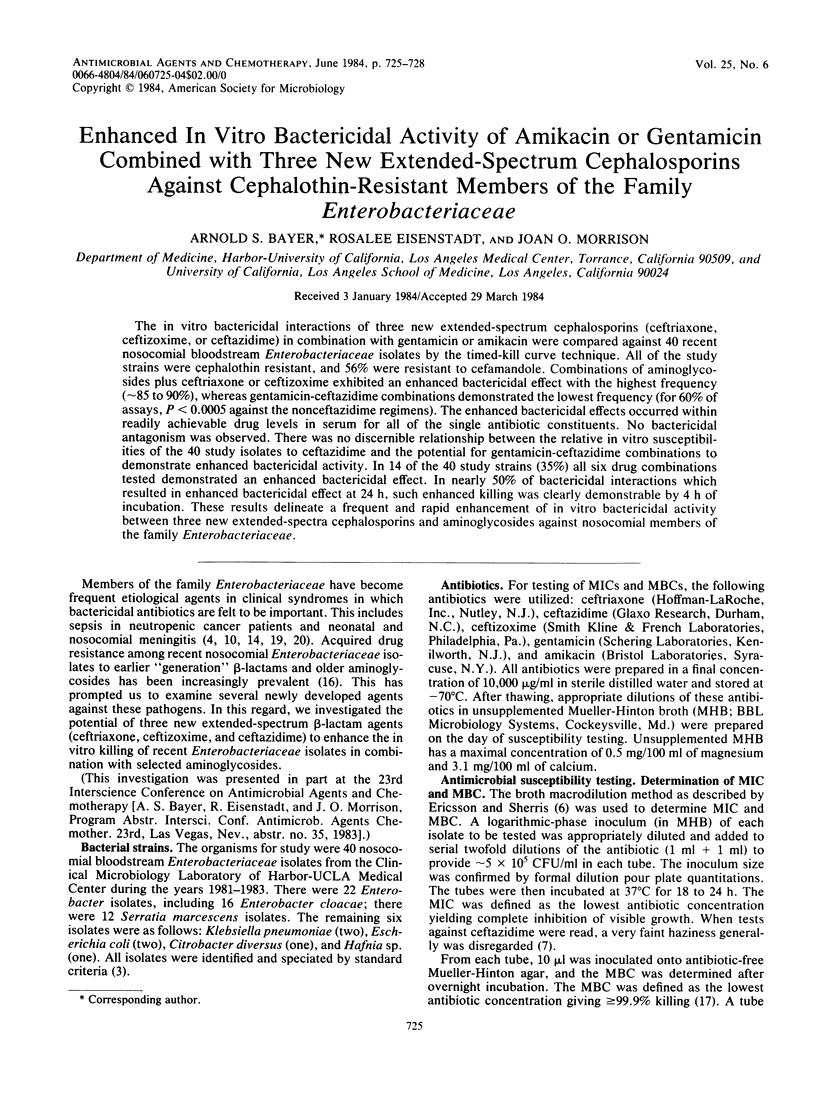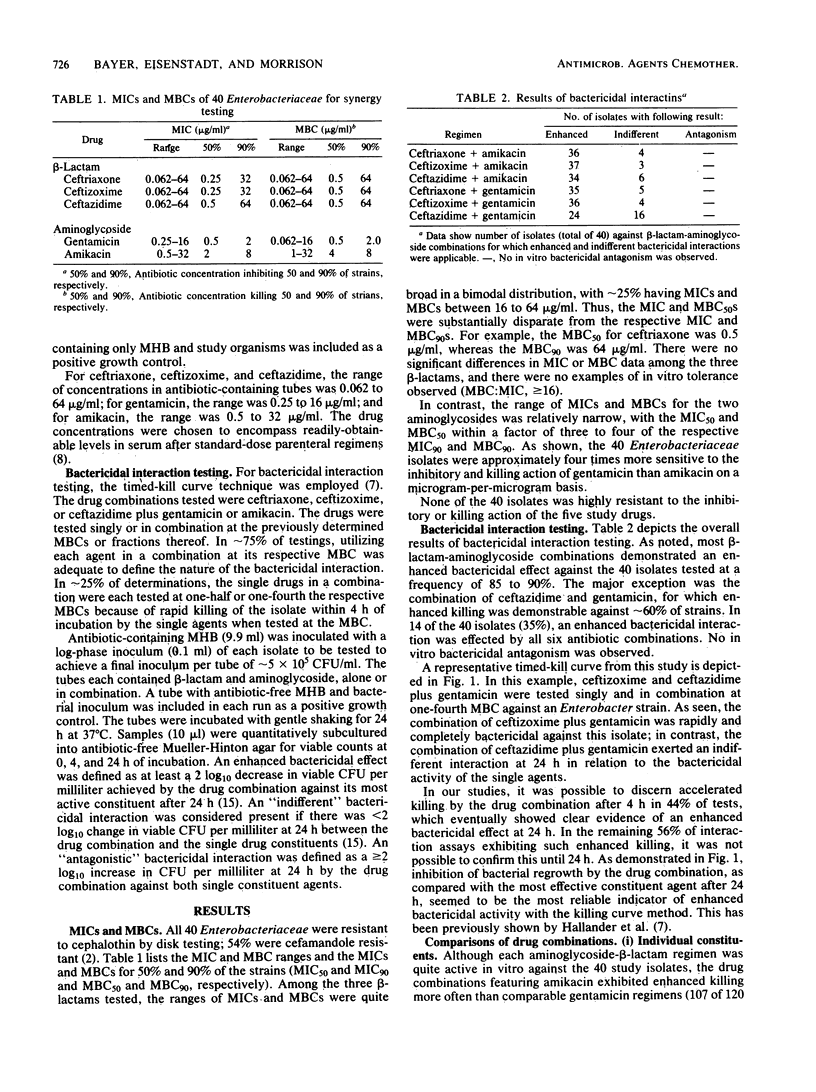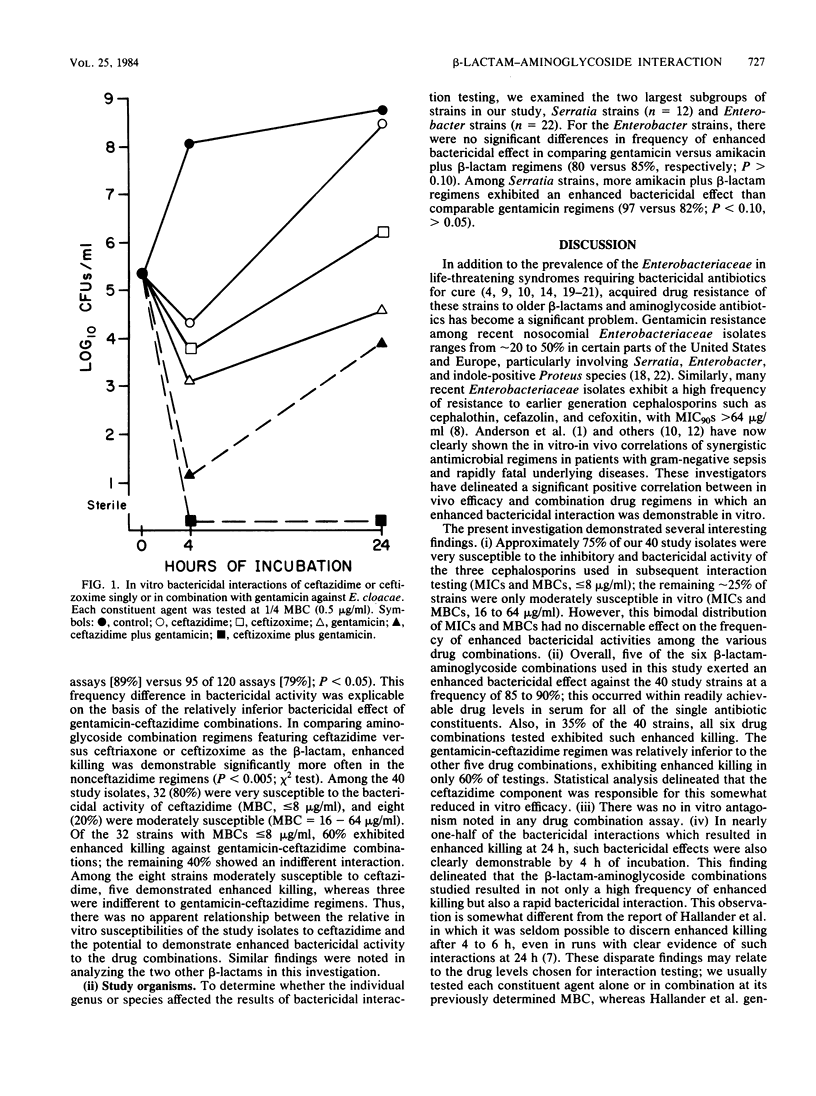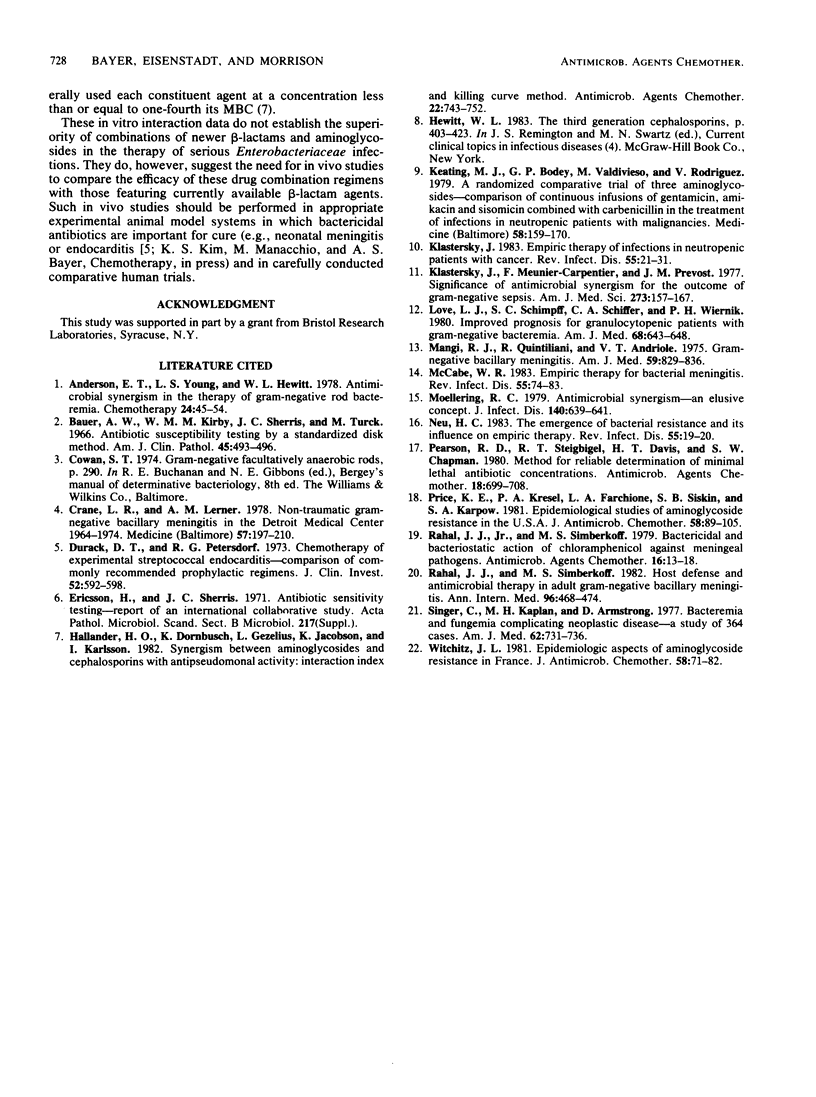Abstract
The in vitro bactericidal interactions of three new extended-spectrum cephalosporins (ceftriaxone, ceftizoxime, or ceftazidime) in combination with gentamicin or amikacin were compared against 40 recent nosocomial bloodstream Enterobacteriaceae isolates by the timed-kill curve technique. All of the study strains were cephalothin resistant, and 56% were resistant to cefamandole. Combinations of aminoglycosides plus ceftriaxone or ceftizoxime exhibited an enhanced bactericidal effect with the highest frequency (approximately 85 to 90%), whereas gentamicin-ceftazidime combinations demonstrated the lowest frequency (for 60% of assays, P less than 0.0005 against the nonceftazidime regimens). The enhanced bactericidal effects occurred within readily achievable drug levels in serum for all of the single antibiotic constituents. No bactericidal antagonism was observed. There was no discernible relationship between the relative in vitro susceptibilities of the 40 study isolates to ceftazidime and the potential for gentamicin-ceftazidime combinations to demonstrate enhanced bactericidal activity. In 14 of the 40 study strains (35%) all six drug combinations tested demonstrated an enhanced bactericidal effect. In nearly 50% of bactericidal interactions which resulted in enhanced bactericidal effect at 24 h, such enhanced killing was clearly demonstrable by 4 h of incubation. These results delineate a frequent and rapid enhancement of in vitro bactericidal activity between three new extended-spectra cephalosporins and aminoglycosides against nosocomial members of the family Enterobacteriaeceae.
Full text
PDF



Selected References
These references are in PubMed. This may not be the complete list of references from this article.
- Anderson E. T., Young L. S., Hewitt W. L. Antimicrobial synergism in the therapy of gram-negative rod bacteremia. Chemotherapy. 1978;24(1):45–54. doi: 10.1159/000237759. [DOI] [PubMed] [Google Scholar]
- Bauer A. W., Kirby W. M., Sherris J. C., Turck M. Antibiotic susceptibility testing by a standardized single disk method. Am J Clin Pathol. 1966 Apr;45(4):493–496. [PubMed] [Google Scholar]
- Crane L. R., Lerner A. M. Non-traumatic gram-negative bacillary meningitis in the Detroit Medical Center, 1964-1974; (with special mention of cases due to Escherichia coli). Medicine (Baltimore) 1978 May;57(3):197–209. doi: 10.1097/00005792-197805000-00001. [DOI] [PubMed] [Google Scholar]
- Durack D. T., Petersdorf R. G. Chemotherapy of experimental streptococcal endocarditis. I. Comparison of commonly recommended prophylactic regimens. J Clin Invest. 1973 Mar;52(3):592–598. doi: 10.1172/JCI107220. [DOI] [PMC free article] [PubMed] [Google Scholar]
- Ericsson H. M., Sherris J. C. Antibiotic sensitivity testing. Report of an international collaborative study. Acta Pathol Microbiol Scand B Microbiol Immunol. 1971;217(Suppl):1+–1+. [PubMed] [Google Scholar]
- Hallander H. O., Dornbusch K., Gezelius L., Jacobson K., Karlsson I. Synergism between aminoglycosides and cephalosporins with antipseudomonal activity: interaction index and killing curve method. Antimicrob Agents Chemother. 1982 Nov;22(5):743–752. doi: 10.1128/aac.22.5.743. [DOI] [PMC free article] [PubMed] [Google Scholar]
- Keating M. J., Bodey G. P., Valdivieso M., Rodriguez V. A randomized comparative trial of three aminoglycosides--comparison of continuous infusions of gentamicin, amikacin and sisomicin combined with carbenicillin in the treatment of infections in neutropenic patients with malignancies. Medicine (Baltimore) 1979 Mar;58(2):159–170. doi: 10.1097/00005792-197903000-00004. [DOI] [PubMed] [Google Scholar]
- Klastersky J., Meunier-Carpentier F., Prevost J. M. Significance of antimicrobial synergism for the outcome of gram negative sepsis. Am J Med Sci. 1977 Mar-Apr;273(2):157–167. doi: 10.1097/00000441-197703000-00005. [DOI] [PubMed] [Google Scholar]
- Love L. J., Schimpff S. C., Schiffer C. A., Wiernik P. H. Improved prognosis for granulocytopenic patients with gram-negative bacteremia. Am J Med. 1980 May;68(5):643–648. doi: 10.1016/0002-9343(80)90243-0. [DOI] [PubMed] [Google Scholar]
- Mangi R. J., Quintiliani R., Andriole V. T. Gram-negative bacillary meningitis. Am J Med. 1975 Dec;59(6):829–836. doi: 10.1016/0002-9343(75)90468-4. [DOI] [PubMed] [Google Scholar]
- Moellering R. C., Jr Antimicrobial synergism--an elusive concept. J Infect Dis. 1979 Oct;140(4):639–641. doi: 10.1093/infdis/140.4.639. [DOI] [PubMed] [Google Scholar]
- Neu H. C. The emergence of bacterial resistance and its influence on empiric therapy. Rev Infect Dis. 1983 Mar-Apr;5 (Suppl 1):S9–20. doi: 10.1093/clinids/5.supplement_1.s9. [DOI] [PubMed] [Google Scholar]
- Pearson R. D., Steigbigel R. T., Davis H. T., Chapman S. W. Method of reliable determination of minimal lethal antibiotic concentrations. Antimicrob Agents Chemother. 1980 Nov;18(5):699–708. doi: 10.1128/aac.18.5.699. [DOI] [PMC free article] [PubMed] [Google Scholar]
- Price K. E., Kresel P. A., Farchione L. A., Siskin S. B., Karpow S. A. Epidemiological studies of aminoglycoside resistance in the U.S.A. J Antimicrob Chemother. 1981 Jul;8 (Suppl A):89–105. doi: 10.1093/jac/8.suppl_a.89. [DOI] [PubMed] [Google Scholar]
- Rahal J. J., Jr, Simberkoff M. S. Bactericidal and bacteriostatic action of chloramphenicol against memingeal pathogens. Antimicrob Agents Chemother. 1979 Jul;16(1):13–18. doi: 10.1128/aac.16.1.13. [DOI] [PMC free article] [PubMed] [Google Scholar]
- Rahal J. J., Simberkoff M. S. Host defense and antimicrobial therapy in adult gram-negative bacillary meningitis. Ann Intern Med. 1982 Apr;96(4):468–474. doi: 10.7326/0003-4819-96-4-468. [DOI] [PubMed] [Google Scholar]
- Singer C., Kaplan M. H., Armstrong D. Bacteremia and fungemia complicating neoplastic disease. A study of 364 cases. Am J Med. 1977 May;62(5):731–742. doi: 10.1016/0002-9343(77)90876-2. [DOI] [PubMed] [Google Scholar]
- Witchitz J. L. Epidemiological aspects of aminoglycoside resistance in France. J Antimicrob Chemother. 1981 Jul;8 (Suppl A):71–82. doi: 10.1093/jac/8.suppl_a.71. [DOI] [PubMed] [Google Scholar]


